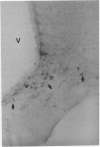Abstract
Nitric oxide (NO) synthase, the enzyme which converts arginine into citrulline plus NO, a highly active free radical, has been found in many neurons in the brain, including neurons in the hypothalamus. Our previous experiments showed that norepinephrine-induced prostaglandin E2 release from hypothalamic explants incubated in vitro is mediated by NO. Since the release of luteinizing hormone-releasing hormone (LHRH) is also driven by norepinephrine and prostaglandin E2, we hypothesized that NO might also control pulsatile release of LHRH in vivo, resulting in turn in pulsatile release of luteinizing hormone (LH). To ascertain the role of NO in control of pulsatile LH release in vivo, an inhibitor of NO synthase, NG-monomethyl-L-arginine (NMMA), was microinjected into the third cerebral ventricle (1 mg/5 microliters) of conscious castrate male rats at time 0 and 60 min later; blood samples were taken every 10 min during this period. NMMA blocked pulsatile LH release within 20 min, and plasma LH concentration declined further without pulses after the injection at 60 min. Pulsatile release of LH was not altered in diluent-injected controls. NMMA did not alter pulsatile release of follicle-stimulating hormone, which suggests that its release does not require NO. Incubation of medial basal hypothalami with norepinephrine (10 microM) induced an increase in LHRH release that was inhibited by NMMA (300 microM). NMMA alone did not alter basal LHRH release, whereas it was augmented by sodium nitroprusside (100 microM), which releases NO spontaneously. This augmentation was prevented by hemoglobin (2 micrograms/ml), which binds the NO released by nitroprusside. Our previous experiments showed that norepinephrine-induced release of prostaglandin E2 is mediated by NO. Nitric oxidergic neurons were visualized in the median eminence adjacent to the LHRH terminals. The combined in vivo and in vitro results indicate that the pulsatile release of LHRH induced by norepinephrine is brought about by alpha 1-adrenergic activation of NO synthase. NO then induces prostaglandin E2 release that activates exocytosis of LHRH secretory granules into the portal vessels to induce pulsatile LH release.
Full text
PDF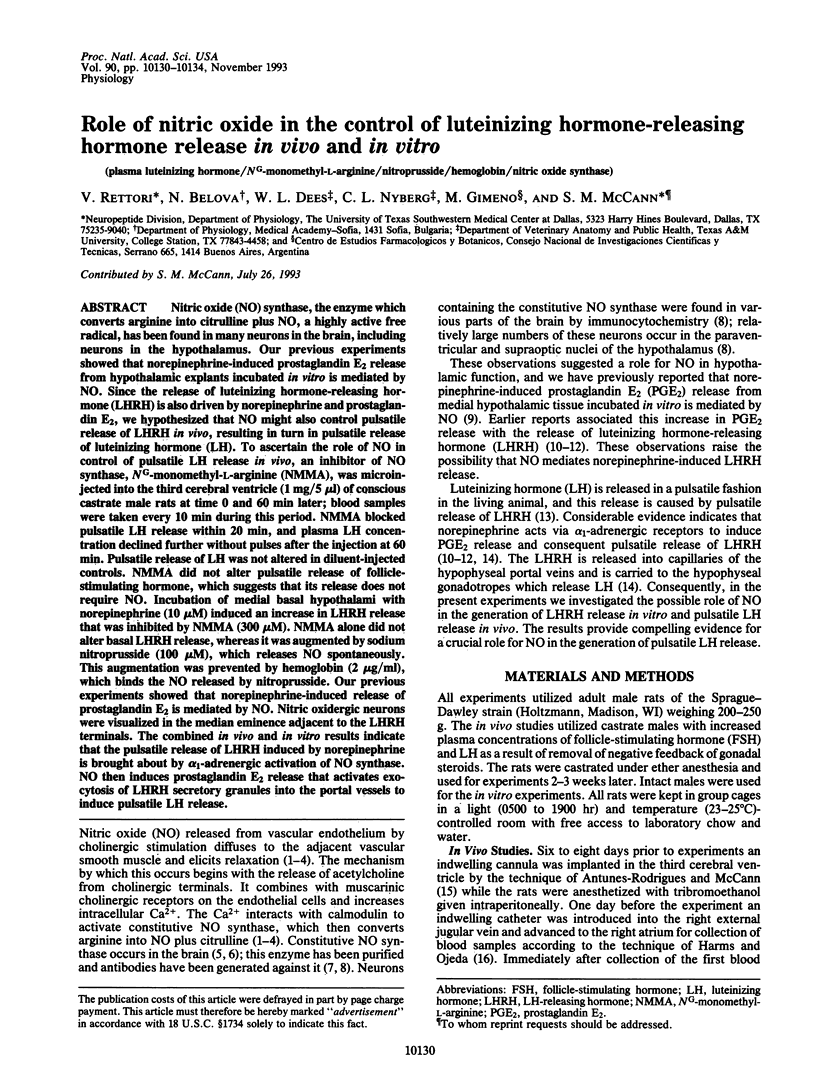
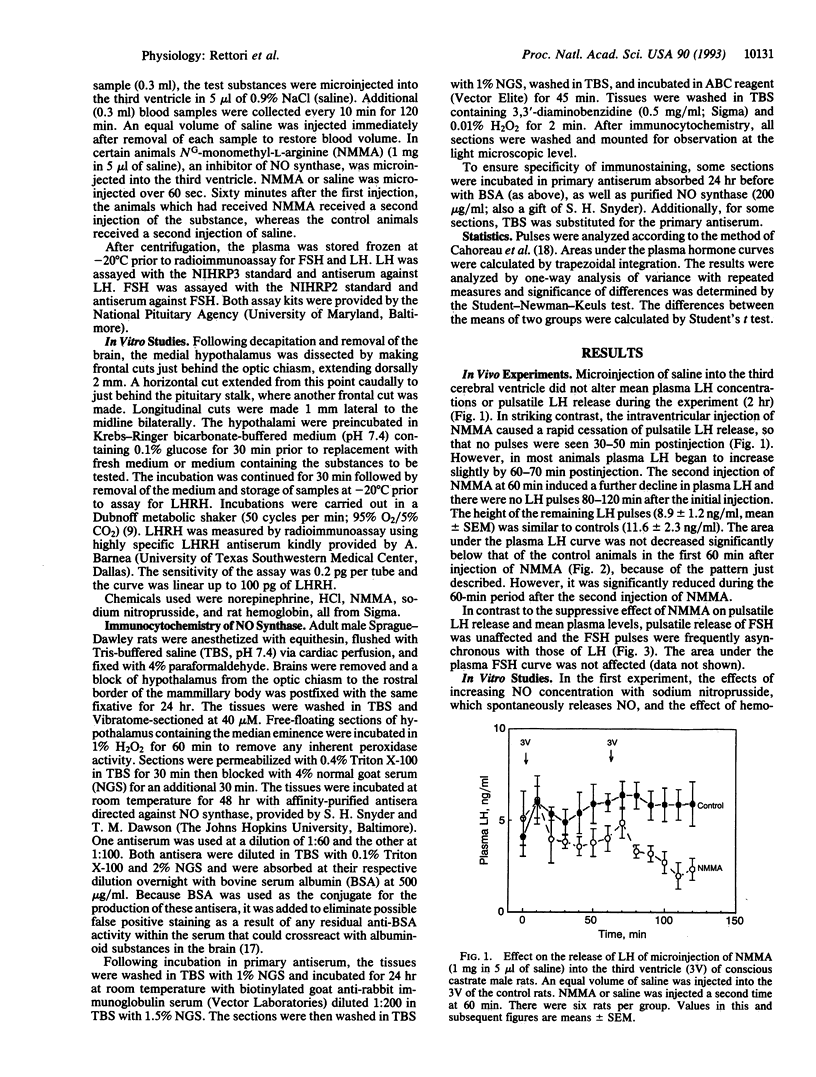

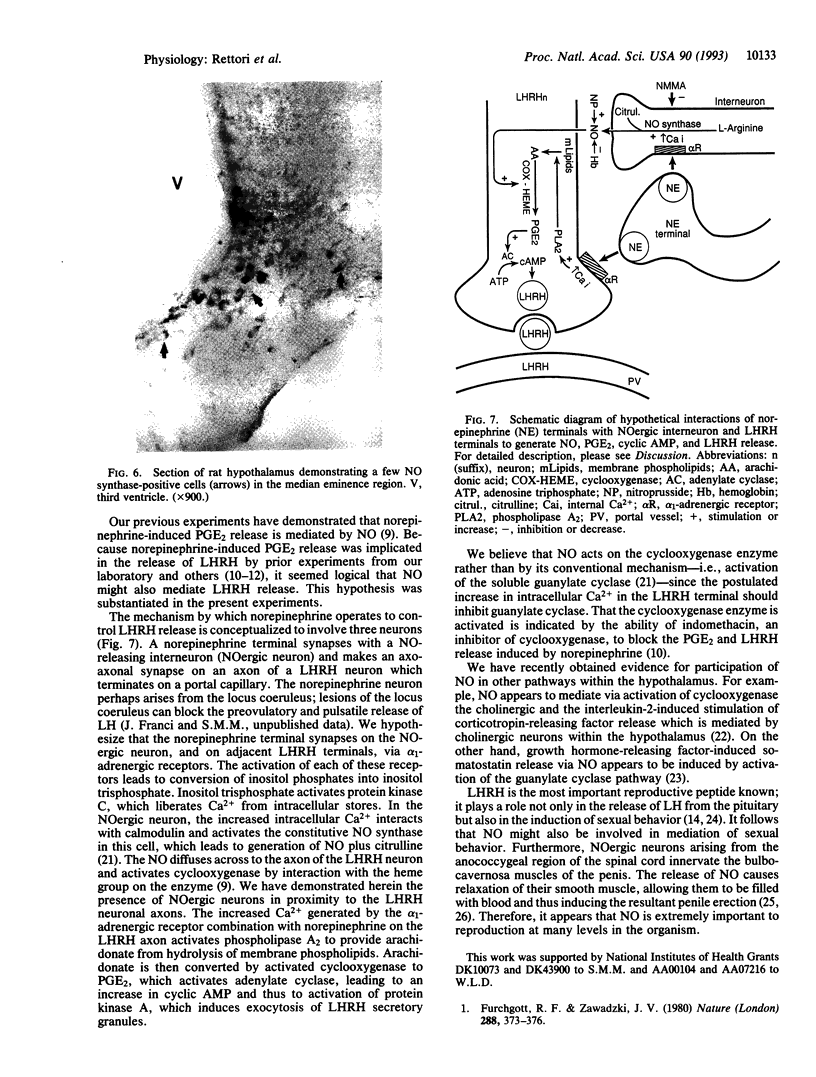
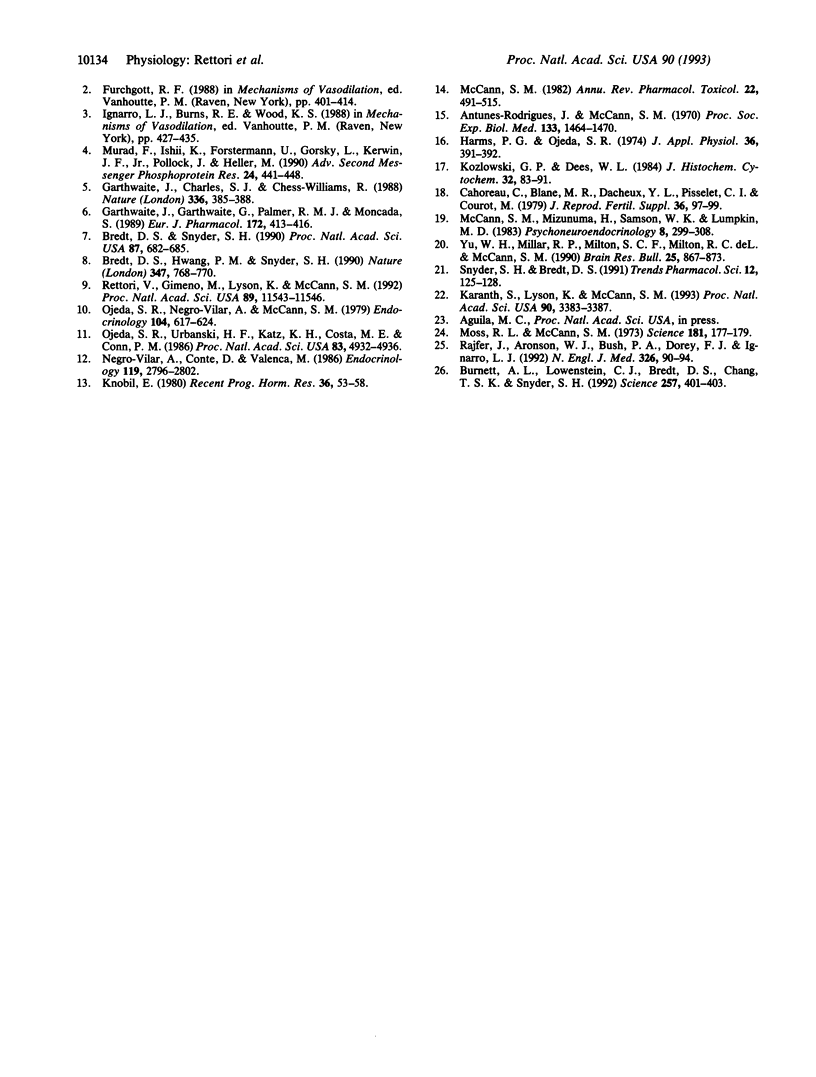
Images in this article
Selected References
These references are in PubMed. This may not be the complete list of references from this article.
- Antunes-Rodrigues J., McCann S. M. Water, sodium chloride, and food intake induced by injections of cholinergic and adrenergic drugs into the third ventricle of the rat brain. Proc Soc Exp Biol Med. 1970 Apr;133(4):1464–1470. doi: 10.3181/00379727-133-34713. [DOI] [PubMed] [Google Scholar]
- Bredt D. S., Hwang P. M., Snyder S. H. Localization of nitric oxide synthase indicating a neural role for nitric oxide. Nature. 1990 Oct 25;347(6295):768–770. doi: 10.1038/347768a0. [DOI] [PubMed] [Google Scholar]
- Bredt D. S., Snyder S. H. Isolation of nitric oxide synthetase, a calmodulin-requiring enzyme. Proc Natl Acad Sci U S A. 1990 Jan;87(2):682–685. doi: 10.1073/pnas.87.2.682. [DOI] [PMC free article] [PubMed] [Google Scholar]
- Burnett A. L., Lowenstein C. J., Bredt D. S., Chang T. S., Snyder S. H. Nitric oxide: a physiologic mediator of penile erection. Science. 1992 Jul 17;257(5068):401–403. doi: 10.1126/science.1378650. [DOI] [PubMed] [Google Scholar]
- Cahoreau C., Blanc M. R., Dacheux J. L., Pisselet C., Courot M. Inhibin activity in ram rete testis fluid: depression of plasma FSH and LH in the castrated and cryptorchid ram. J Reprod Fertil Suppl. 1979;(26):97–116. [PubMed] [Google Scholar]
- Furchgott R. F., Zawadzki J. V. The obligatory role of endothelial cells in the relaxation of arterial smooth muscle by acetylcholine. Nature. 1980 Nov 27;288(5789):373–376. doi: 10.1038/288373a0. [DOI] [PubMed] [Google Scholar]
- Garthwaite J., Charles S. L., Chess-Williams R. Endothelium-derived relaxing factor release on activation of NMDA receptors suggests role as intercellular messenger in the brain. Nature. 1988 Nov 24;336(6197):385–388. doi: 10.1038/336385a0. [DOI] [PubMed] [Google Scholar]
- Garthwaite J., Garthwaite G., Palmer R. M., Moncada S. NMDA receptor activation induces nitric oxide synthesis from arginine in rat brain slices. Eur J Pharmacol. 1989 Oct 17;172(4-5):413–416. doi: 10.1016/0922-4106(89)90023-0. [DOI] [PubMed] [Google Scholar]
- Harms P. G., Ojeda S. R. A rapid and simple procedure for chronic cannulation of the rat jugular vein. J Appl Physiol. 1974 Mar;36(3):391–392. doi: 10.1152/jappl.1974.36.3.391. [DOI] [PubMed] [Google Scholar]
- Karanth S., Lyson K., McCann S. M. Role of nitric oxide in interleukin 2-induced corticotropin-releasing factor release from incubated hypothalami. Proc Natl Acad Sci U S A. 1993 Apr 15;90(8):3383–3387. doi: 10.1073/pnas.90.8.3383. [DOI] [PMC free article] [PubMed] [Google Scholar]
- Knobil E. The neuroendocrine control of the menstrual cycle. Recent Prog Horm Res. 1980;36:53–88. doi: 10.1016/b978-0-12-571136-4.50008-5. [DOI] [PubMed] [Google Scholar]
- Kozlowski G. P., Dees W. L. Immunocytochemistry for LHRH neurons in the arcuate nucleus area of the rat: fact or artifact? J Histochem Cytochem. 1984 Jan;32(1):83–91. doi: 10.1177/32.1.6690601. [DOI] [PubMed] [Google Scholar]
- McCann S. M., Mizunuma H., Samson W. K., Lumpkin M. D. Differential hypothalamic control of FSH secretion: a review. Psychoneuroendocrinology. 1983;8(3):299–308. doi: 10.1016/0306-4530(83)90004-5. [DOI] [PubMed] [Google Scholar]
- McCann S. M. Physiology and pharmacology of LHRH and somatostatin. Annu Rev Pharmacol Toxicol. 1982;22:491–515. doi: 10.1146/annurev.pa.22.040182.002423. [DOI] [PubMed] [Google Scholar]
- Moss R. L., McCann S. M. Induction of mating behavior in rats by luteinizing hormone-releasing factor. Science. 1973 Jul 13;181(4095):177–179. doi: 10.1126/science.181.4095.177. [DOI] [PubMed] [Google Scholar]
- Murad F., Ishii K., Förstermann U., Gorsky L., Kerwin J. F., Jr, Pollock J., Heller M. EDRF is an intracellular second messenger and autacoid to regulate cyclic GMP synthesis in many cells. Adv Second Messenger Phosphoprotein Res. 1990;24:441–448. [PubMed] [Google Scholar]
- Negro-Vilar A., Conte D., Valenca M. Transmembrane signals mediating neural peptide secretion: role of protein kinase C activators and arachidonic acid metabolites in luteinizing hormone-releasing hormone secretion. Endocrinology. 1986 Dec;119(6):2796–2802. doi: 10.1210/endo-119-6-2796. [DOI] [PubMed] [Google Scholar]
- Ojeda S. R., Negro-Vilar A., McCann S. M. Release of prostaglandin Es by hypothalamic tissue: evidence for their involvement in catecholamine-induced luteinizing hormone-releasing hormone release. Endocrinology. 1979 Mar;104(3):617–624. doi: 10.1210/endo-104-3-617. [DOI] [PubMed] [Google Scholar]
- Ojeda S. R., Urbanski H. F., Katz K. H., Costa M. E., Conn P. M. Activation of two different but complementary biochemical pathways stimulates release of hypothalamic luteinizing hormone-releasing hormone. Proc Natl Acad Sci U S A. 1986 Jul;83(13):4932–4936. doi: 10.1073/pnas.83.13.4932. [DOI] [PMC free article] [PubMed] [Google Scholar]
- Rajfer J., Aronson W. J., Bush P. A., Dorey F. J., Ignarro L. J. Nitric oxide as a mediator of relaxation of the corpus cavernosum in response to nonadrenergic, noncholinergic neurotransmission. N Engl J Med. 1992 Jan 9;326(2):90–94. doi: 10.1056/NEJM199201093260203. [DOI] [PubMed] [Google Scholar]
- Rettori V., Gimeno M., Lyson K., McCann S. M. Nitric oxide mediates norepinephrine-induced prostaglandin E2 release from the hypothalamus. Proc Natl Acad Sci U S A. 1992 Dec 1;89(23):11543–11546. doi: 10.1073/pnas.89.23.11543. [DOI] [PMC free article] [PubMed] [Google Scholar]
- Snyder S. H., Bredt D. S. Nitric oxide as a neuronal messenger. Trends Pharmacol Sci. 1991 Apr;12(4):125–128. doi: 10.1016/0165-6147(91)90526-x. [DOI] [PubMed] [Google Scholar]
- Yu W. H., Millar R. P., Milton S. C., Milton R. C., McCann S. M. Selective FSH-releasing activity of [D-Trp9]GAP1-13: comparison with gonadotropin-releasing abilities of analogs of GAP and natural LHRHs. Brain Res Bull. 1990 Dec;25(6):867–873. doi: 10.1016/0361-9230(90)90182-y. [DOI] [PubMed] [Google Scholar]



